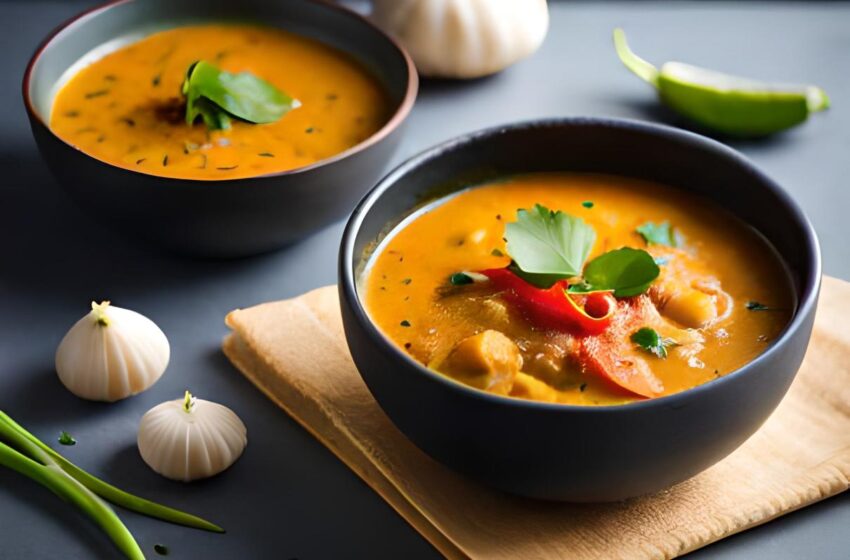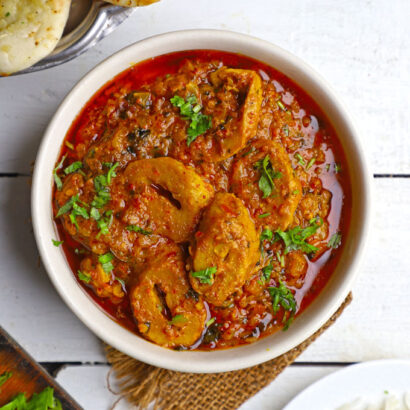Welcome to my thriving food corner! With the Sambar, a well-known South Indian dish, we’re delving into the wholesome world of South Indian food today. Get ready for a flavor-filled rollercoaster that will pique your taste senses like no before. This Sambar dish will take you right to the busy streets of Chennai and the warm kitchens of Kerala, whether you adore spices or are looking for comfort in a bowl.
Table of Contents
Introduction to Sambar
A delicious combination of toor dal (pigeon peas) and a variety of vegetables, imbued with a symphony of aromatic spices, is sambar, the heart and soul of South Indian cuisine. It has a long history that spans back centuries, and each home gives this comfort food a special touch. A bowl of sambar contains a story about tradition, love, and a flavour explosion that will leave you wanting more.
Serving Size of this Sambar recipe
4-6 servings You’ll be rewarded with a hearty and healthful South Indian pleasure if you set out 45 minutes to prepare and 30 minutes to cook.
Prep Time & Cook Time
| Prep Time ⏱️ | Cook Time ⏱️ | Total Time ⏱️ |
|---|---|---|
| 25 mins | 30 mins | 55 mins |
Calorie and Micronutrient Breakdown
| Nutrient | Amount per Serving |
|---|---|
| Calories | 180 kcal |
| Carbohydrates | 30.5 g |
| Protein | 7.8 g |
| Dietary Fiber | 8.2 g |
| Vitamin A | 3456 IU |
| Vitamin C | 28.4 mg |
| Folate | 57.6 mcg |
| Potassium | 685 mg |
| Iron | 2.7 mg |
| Magnesium | 57.8 mg |
| Zinc | 1.3 mg |
| Copper | 0.3 mg |
| Manganese | 0.5 mg |
| Phosphorus | 128 mg |
| Selenium | 4.9 mcg |
Ingredients
| Ingredient | Quantity |
|---|---|
| Toor Dal | 1 cup |
| Mixed Vegetables | 2 cups |
| Tamarind | Small Lemon-sized |
| Sambar Powder | 2 tbsp |
| Turmeric Powder | 1/2 tsp |
| Red Chili Powder | 1/2 tsp |
| Asafoetida (Hing) | 1/4 tsp |
| Curry Leaves | 1 sprig |
| Mustard Seeds | 1 tsp |
| Cumin Seeds | 1 tsp |
| Fenugreek Seeds | 1/4 tsp |
| Oil | 2 tbsp |
| Salt | To taste |
Step-by-step Cooking Instructions of Sambar Recipe
- Get the Dal ready: Toor dal should be carefully washed before pressure cooking it with 2 cups of water until it is mushy and soft.
- To extract tamarind, soak it in warm water for about 15 minutes. To remove the pulp, squeeze it; after that, strain it and set it away.
- The mixed veggies should be cooked until they are soft in a separate saucepan. Drumsticks, carrots, beans, and eggplant can all be combined.
- Making the Sambar Base: Heat oil in a large pan. Splutter the mustard seeds after adding them. Add the curry leaves, cumin seeds, and fenugreek seeds after that.
- Spices and Aromatics: Include asafoetida, red chilli powder, and turmeric powder. The flavours should be sautéed for a minute to combine.
- Sambar powder, tamarind extract, and tamarind juice should be added.
Sambar recipe video tutorial
What to Serve Alongside Sambar
Sambar pairs well with a number of favourite South Indian dishes. Try it with plain chapati, steamed rice, dosa, idli, or even vada. The delicious combination will create a symphony for your palate.
Variations of Sambar Recipe
Sambar has a wide variety of avatars, each with an own twist. You can play about with the type of vegetables you use, the heat setting, and even the broth’s consistency. Several well-liked versions include:
Arachuvitta Sambar: contains freshly ground spices, giving it an earthy and aromatic flavour.
Varutharacha Sambar: Roasted coconut and spices are combined in a grinder to create a flavorful, textured dish.
Kadamba Sambar: A festival favourite, this variation of sambar recipe is a mash-up of local ingredients and foreign spices.
Healthier Version of Sambar Recipe
For those looking for a lighter version of this classic dish, here’s a healthy twist:
- Use less oil for tempering and opt for heart-healthy oils like coconut or olive oil.
- Load up on nutrient-rich vegetables to boost the fiber content.
- Consider reducing the amount of tamarind pulp to cut down on the tanginess.
Vegan Sambar Recipe
Here’s a nutritious variation on this traditional dish for those seeking a lighter option:
- If you must temper with oil, use less of it and choose heart-healthy oils like coconut or olive oil.
- Fill up on nutrient-dense vegetables to increase the amount of fibre.
- To lessen the tanginess, think about using less tamarind pulp.
Non-Vegetarian Twist to Sambar Recipe
Here is a special variant for individuals who enjoy delicious non-vegetarian foods:
- Change the mixed veggies for chunks of boneless chicken or fish.
- In order to make sure your meat is soft and properly cooked, adjust the cooking time accordingly.
History of Sambar
The Maratha king Shivaji’s reign in the 17th century is when Sambar first appeared. This meal is thought to have been brought to the southern regions by the Marathas, where it underwent a number of changes to become the cherished Sambar we know today. Since then, the dish has changed, influenced by many different culinary customs, and has become a fundamental component of South Indian cuisine.
References: History of Sambar
Fun Facts
- According to legend, the Marathi term “sambhar,” which signifies a hot condiment, is where the name “sambar” first appeared.
- Sambar is a regular meal made using locally sourced veggies in South Indian homes.
- Each Sambar experience is absolutely distinct due to the wide variations in sambar masala from place to region.
Conclusion
Sambar is a genuine work of South Indian cuisine, boasting a spellbinding combination of flavours and spices. It’s more than simply a meal; it’s a trip through history, tradition, and India’s diverse cultural heritage. Sambar is a dish that never fails to delight and satisfy, whether you prepare it for your family or have it at a nearby restaurant.
FAQs
1. Is it possible to prepare sambar using only one kind of vegetable?
Yes, you can make sambar recipe using a single vegetable like pumpkin, drumstick, brinjal etc
2. Is Sambar too spicy for those who can’t eat spicy food?
Not at all! Just add spicier ingredient basis your taste and preference
3. Can I use ready-made Sambar powder available in retail stores?
Yes, store-bought sambar powder serves well for this sambar recipe
4. How to achieve perfect sambar consistency?
The secret is a perfect blend of dal, veggies, water & tamarind. Adjust the ratio till you achieve perfect consistency.
5. Can I store leftover Sambar in the freezer?
Yes absolutely! You can store the sambar in an airtight container for up to two weeks. And when you crave the south Indian taste, just reheat and consume.
6. Is Sambar a complete meal in itself?
Sambar is a healthful dish that is filled with veggies and dal. To make a meal that is balanced, it is best enjoyed with a carbohydrate source like rice or bread.
7. Can I use canned lentils instead of cooking toor dal?
To save time, tinned lentils can be used in place of fresh dal. Before including them in the recipe, make sure to thoroughly rinse them.
8. Can I prepare Sambar in large quantities and keep it in the fridge?
Certainly! For quick, delicious meals, prepare a larger amount and portion it out into freezer-safe containers.
9. Can I use lemon juice instead of tamarind?
Yes, lemon juice can be used in place of tamarind, however the flavour profile will be slightly different.
10. Is Sambar popular only in South India?
While Sambar’s popularity has extended throughout India and beyond despite its South Indian origins, it has become a favourite among fans of Indian cuisine all over the world.




One Reply to “Sambar Recipe in less than 1 hour: Master the Art of South Indian Culinary Bliss 😋”